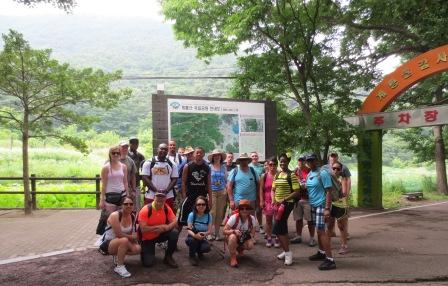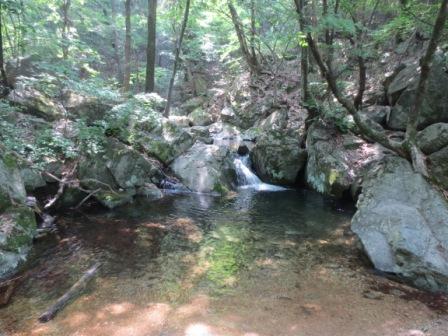Tapgol Park ('Pagoda Park') is located in the center of Seoul very near Insa-dong, a community and shopping district known for its traditional works and for tourists.
Tapgol Park contains stone relics unearthed during Seoul's modern construction. No one is certain where all of the relics came from, but a few are famous and well known.
This marble and granite pagoda was also built for Wongaksa in 1465. It is 12m in height (about 36 feet). Because of the glass and a barrier around the case, I could not photograph the intricate detail of the this piece. It is amazing. There are 10 levels, several of which depict the life and works of Buddha. His likeness is carved in detail and three dimensions on several of the small levels. It is far more beautiful than my sorry photo.
Tapgol Park is also the site of the March 1st Movement of 1919, a student and activist uprising in Korea demanding independence for the country. Japan 'colonized' Korea in 1910 and committed quite a few atrocities which the Koreans feel they still have not admitted to or apologized for. This is one of the leaders of that movement, who helped write and read their Korean Declaration of Independence. After the gathering, its leaders notified the police of their treason and were arrested. What followed was a large uprising that the police were unable to quell. The military was called in, and protesters were killed. This lasted for many years, with a few leaders lucky enough to escape to China and continue their quest for Korean autonomy. Korea was one country at this time, not divided like it is now.
There were several of these bronze bas-relief statues commemorating the March 1st Movement, aka Samil Movement. 'Sam' is the pronunciation for the number 3 and 'il' (more like 'eel' for those of us from the southern United States) is the pronunciation for the number 1, so literally 3-1. The fellows holding the weapons are Japanese military.
The signs around these monuments were not in English (there often are English, Chinese and Japanese translations on the Korean historical markers), so I am not sure, but I think this one depicts the one female leader of the March 1 Movement, 'Maria' Kim, with one of the many male leaders. Ms. Kim was arrested, imprisoned, tortured, and, as a result from the wounds of her torture, died in 1944, only one year before her country would see a chance for autonomy.
This monument shows the students overpowering the police. Many of the early independence meetings were held in an American Presbyterian church still standing near the park. Some church members definitely assisted in the beginnings of the Samil Movement but not so much in the actual fighting. I have not heard of any American church members arrested, etc.
As I have said in earlier blogs, if you want to know more, check out Wikipedia. From what I have read, Japan maintained their control until World War II, when the Korean people were told they would have independence 'eventually'. And then the Korean War happened, how I will leave for someone who is actually a historian, and here we are today. I will say that all of the Korean people I have asked want reunification for the peninsula, but all also believe a major war is the only way that could happen, and no one wants that.























































